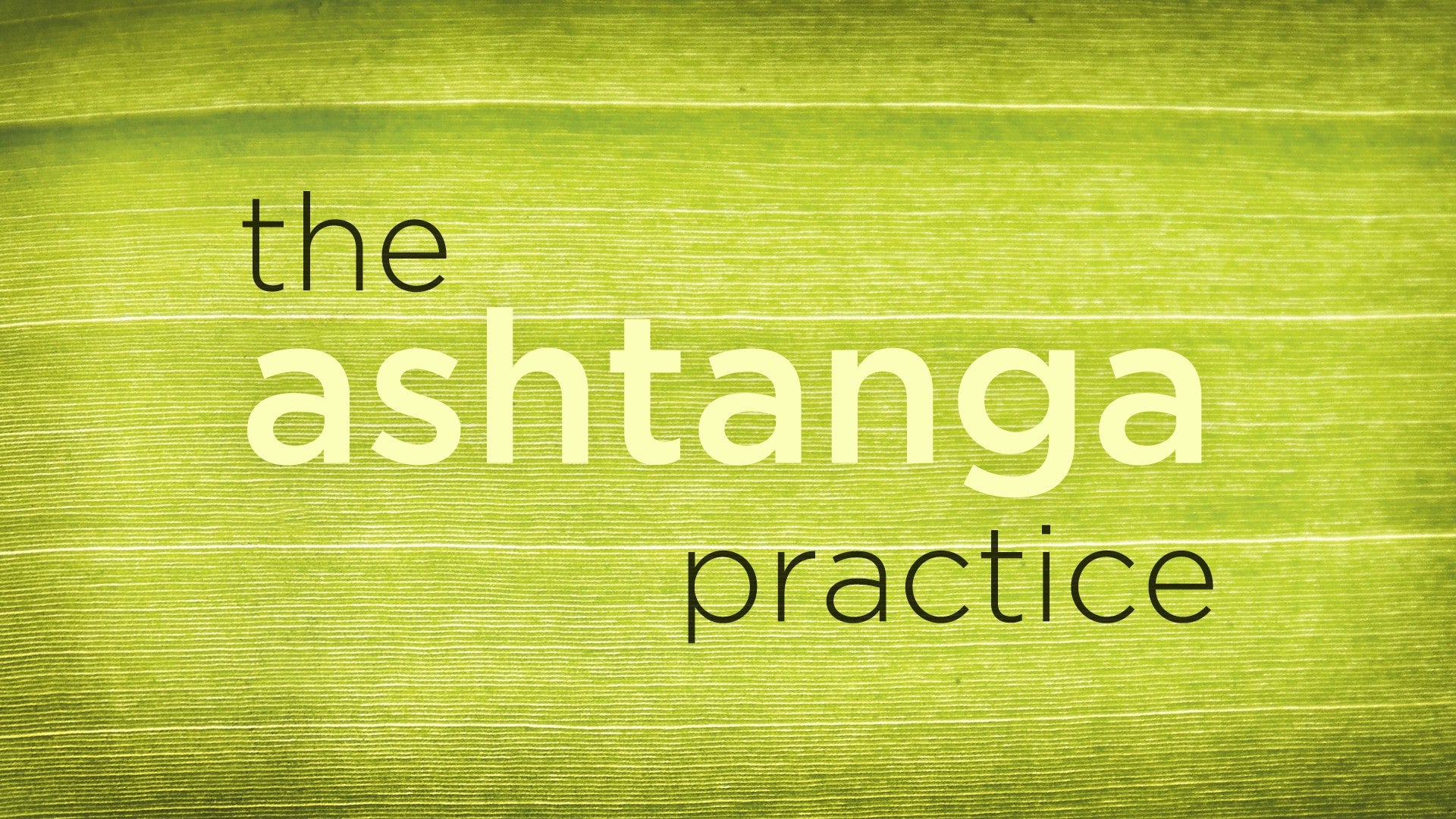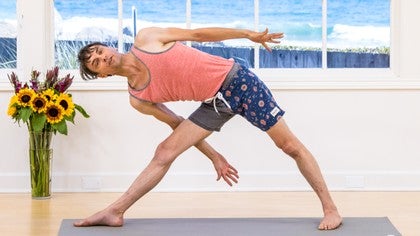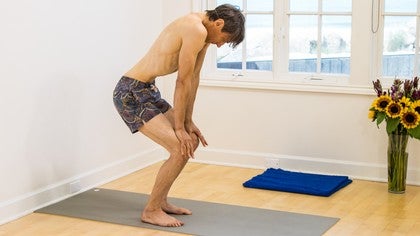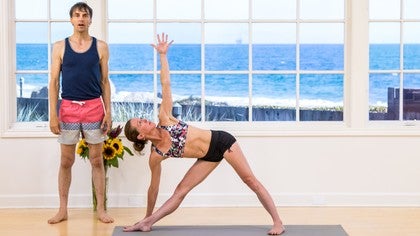Description
About This Video
Transcript
Read Full Transcript
Greetings. Welcome to session three. So this is gonna be an introduction to the standing postures. So in the Ashtanga sequence we're learning, we start each day, you start with and you do the same same basic routine. In the middle, there's variety, but the way you start and the way you finish are the same every day.
So you start with Surya Namaskara and then you move on to standing postures, so we're going to look at those beginning sequence of standing postures today. And our theme for the day our limb is asana, okay? And of everything you can think about about postures, I'm giving you this one idea, which is that asana amounts to what I call belly power. Okay, it's making your center come alive so that you inhabit your physical body. Okay?
And that is like yoga gold. Right? To awaken your center. And you use posture and breathing and all the various techniques, that's, that's their core. Okay?
So here we go. Well, we're gonna start our session with Surya Namaskara. And here we go. Start in the zero position. Samastitihi, which means equal standing or equal grounding, so your feet are together.
They're planted. The thighs are firm, lift up the navel. Let the spine grow up out of the pelvis so the chest opens, the upper chest. Roll the heads of the arms back until they're in the side plane. Feel the scapula on the backside of the body go down towards the middle and forward into the body.
Reach down through the arm actively from shoulder through fingertips. Internalize the senses and enjoy this clear standing position. Okay, and then here we go. Reach the arms up with an inhalation. Come to the end point of first position.
Exhale, project the spine out. Come down into second position, forward fold, plant the hands and feet. Release the spine and head. Then inhale, lift the chest, lift the head, get ready. So the legs are grounded and then they go into a crouch.
Stay forward and spring. Come down to Chaturanga, the four limbs staff and stop. Roll over the tops of the feet, straighten the arms. Lift up the chest, look up and over. Then pull the hips back smoothly with a move.
Come into sixth position. And instantly make a connection with your breath. So in the Surya Namaskara, you flow up until the sixth position and you stay for five to eight counts, so it's around five breaths worth of listening to the sound. Remember, you're elongating your limbs. Elongating your spine in a diagonal from the pelvic floor down through the crown of the head.
And then get ready, bend the knees into a crouch, an animal-ready position and then spring. Plant the feet when you arrive, firm the legs, lift the sitting bones, lift the chest. And stop at the end point of seventh position with full lungs and exhale, keep your weight forward. Enjoy eighth position. Inhale, reach out to the sides.
Sweep the arms up with a move, and stop. Looking up with a steady gaze past the thumbs. Turn the palms out. Return to Samastitihi. We'll do it again, little faster.
Reach up as you breathe in. Enjoy that end point. Exhale dynamic fold, stop your body. Inhale, lift the chest, keep your weight forward and crouch and spring. Stop upon landing, roll over the tops of the feet, lift up the chest, look up and over and pull the hips back smoothly with the out breath.
Enjoy the pause in sixth position. Enjoying the two skeletal lines. So you've got the hip. Knee, ankle, so the leg line. Very tall, grounded legs.
And then you have the second line from the pelvic floor through the pelvis, torso, arms, one long, continuous diagonal line that we call Sushumna, the most glorious axis. Then get ready, crouch as you empty the lungs and spring, fill up the lungs as you lift the chest high, project the navel away from the pelvis, ground your legs, and exhale. Smoothly stop at the endpoint of your fold. Come up, grounding the legs, drop your gaze, drop you chin, scan down the body as you reach up, slenderize all the main body masses along the axis and swim the arms to Samastitihi. Okay, so we'll look at the standing postures now.
So take your hands to your waist. Starts with two standing forward bends, so we know this theme. Um, separate the feet with a hop. Let's do that a few times. So crouch, and spring the legs together.
And then crouch, and spring, separate the feet with a nimble hop. And again, crouch, spring. Crouch, spring, crouch, spring, back and forth. Tume, tume, tume, tume, it's a very percussive, rhythmic kind of thing, that dynamism that you create with the jumping. Okay, so remember one thing.
The asanas have a complexity, right? There's a lot to think about, oh my god. As you may have noticed, from our prior sessions. But, then you got this that offsets that. There's really only one asana, only one.
Okay, and so once you get that, then it's easy. It's just repeating the same thing over. And you have these categories, too. So the forward bend category. And here we go, separate the feet with the hop.
And remember we've already worked on this. Lift up the chest and ground the thighs and then we'll do it, come halfway forward with a move. Okay, look at my body for a sec. Okay, I my spine is long and it goes up, out, and forward. So its very last direction is down.
You think of a forward bend, yeah you go down here. No, but that's the last direction. It's up, out, forward, oh, and finally, down. Okay, let's do that. Take the hands to the waist.
Lift up the torso, go out, forward, and finally down. And come back up and do it with speed. So, partly you have to trick your mind, 'cause the mind will if you think about it, it'll hold back. You'll go like this. Wait, I go, I go up, I go out, uh, and then what?
(giggles) Right? So you have to trick yourself, you have to make a commit to it. It's a trust thing, you have to go whoa! Try it, I wanna (screams) when you do it. So it's a (heavily exhales) Let's do it together. So my feet are separated.
Take your hands and push your thighs, lift up the chest and then (heavily exhales) throw the spine forward. The torso projects away from the legs, and the legs respond by waking up. Okay? So that's your move. And I'm kind of showing you the, it's called the Upanishad.
Right, the secret teaching, the hidden thing. That no one really shows you, because when you do it, you look all cool, right? All dignified. Right, halfway forward you come. But inside, there's a riot going on, it's a wow move.
Okay, so come halfway forward, catch your big toes with the two fingers, and that's a snug wrap, and then straighten the arms and legs, shift your weight forward to a tipping point. So this is a very dynamic transition, right? Let's try it again. So you go from standing with the hands at the waist with the move half way down. Catch your toes and then there's another breath in.
That sets up the move, the actual move into position. Okay, so your arms are straight, and it's like you're trying to stand up. You're pulling on your toes. You're trying to stand up, but your toes are going, "No, "you're not going anywhere." Try it, tug on the toes, lift the chest, but ground the feet. Shift the weight forward.
So this is an amazing meditation position all of its own. And you're working to lift the sitting bones. Okay, then when you finally go for the fold, keep the legs as firm as possible. If your backs of the legs are tight, you will bend the knees. Look at me for a sec, so they might, so you're here, right?
You can get 'em possibly straight in the transition, but then when you fold, they'll bend, but then you work on trying to straighten them. So you're lifting the hips, shifting the weight forward, and pulling on your toes. 'Kay, come back into position if you were watching, and here we are. So partly you're just investigating, breathing, experiencing your position. Patiently.
And that's part of that belly power, you're centered. And that's why you would bend your knees. Look at this for a sec. So if I straighten my legs and I'm stiff, I have so little power, actually. So that's why you're (imitates whooshing sound) bending and getting centered, it's like an animal stance that you're in.
Okay, then breathe in, straighten the arms. And let's look at this transition. So you take the hands under. They keep upping the anti on you. In Ashtanga, right?
So it keeps getting more challenging. So now you got your hands under your feet and you get forward, so the exit is not so easy if you go, commit too far. So you have to stay awake, and keep your center. So look it, I'm doing this little rock. Do it with me, rock forward, lift the chest.
And back, rock forward, so almost the heels lift off, and you're stamping your hands with your feet. And pulling up against that. So the chest is lifting up, it's a beautiful position. Without even folding forward. Okay, so the arms and legs are working to get straight, then stay forward.
And that's your end point, and then here we go into the fold. And you stay. Try that again, so lift up the chest, straighten the arms and legs and with one exhalation, come into position. And breathe. Balancing, staying forward enough to balance, lifting the sitting bones.
Freeing the belly, freeing the spine. And lift the chest and head, then keep your long, horizontal spine, take the hands to the waist. And inhale, come up. Whew! Jump the feet together with a move. (chuckles) And there you have the start of the standing postures.
Every transition, you want to kind of look for its dynamic possibilities, the dynamic expression of it. And so when we go between standing postures, we make a dynamic move that's the familiar, that dynamic transition is always a crouch and a spring, so a set up and anticipation and then a release and an expansion, alright? So I'm facing this way in this case, just because of the camera angles. So here you are, you're at the front of your mat. And then you take the arms up with a move, so look, I bring 'em up across as I bend the knees into a crouch.
Okay, let's try that, get that feeling. Okay, so you're in Samastitihi and then you come to here. It's kind of an preparation for action, it's like a coiling. Let's do it, feel this. Like that, so it's done with an exhalation.
It's gonna be like that. Okay? And as usual though, you can crouch and step, you can individualize your dynamism and your destination. So I'll show you the move, and then we'll look at the options. So I go into my crouch and then wow! All of a sudden, spring into a dynamic spread-legged position.
And notice my feet are parallel, my arms are set. And then in the return is the same. You crouch and spring back to Samastitihi. So you can do it with a step, you can crouch and (imitates wooshing noise) Ho-ho! And then, same crouch. The thing you want to avoid is this.
(laughs) Right, and then, right? So it's got to, this is your moment. Such a beautiful opportunity for belly power. And for centeredness, okay? So choose your option and then we're gonna do it back and forth with a rhythm, a crouch, and spring.
Enjoy your landing, and again crouch, and spring. Samastitihi, crouch, spring, straighten the arms and legs and then again crouch. And spring, Samastitihi. Crouch. And now fast.
Listen to that percussion. (laughs) Pow! Okay? So, that's how you work between the standing postures. Now, we're gonna look at Utthita Trikonasana. Extended triangle pose.
So you make a wide stance, angle the right leg out 90-degrees and the left foot in just a little bit. Okay? And so, at first the pelvis is towards level, okay? It's not tipped, it's not tipped to the side, it's not tipped forward. Not tucked under.
Neutral. And that'll mean the navel faces somewhere like, here. Not directly to the side, and you are externally rotating the front thigh and the hip socket, so that will, you can see that and make it happen by making your kneecap face straight up. Okay, look at that. If your kneecap is facing over that way, well, that's not enough.
So you've got to turn it and make it rotate. And then the back does it, but less, okay? That's one key. The front does it very dramatically. The back does it medium until the kneecap faces forward.
Okay? And then, then it's like Samastitihi, so the things keep repeating. Plant the feet, firm the thighs, draw the energy up from the earth, lift the navel, and then Samastitihi arms, right? So take Samastitihi, pretend like this is a very strange Samastitihi. And then tume.
Reach through the arms. And you've got a beautiful position. Okay, and you're ready for action now. So, let's go back for a sec and look at this. Okay, so from Samastitihi, you're going to croach, and spring, and then (imitates whooshing sound) (giggles) Right, it's happened so fast.
Um, so I'm actually, for the purpose of the camera, I'm gonna switch and go this way, and so my spring is going to be different than yours. But you keep crouching and springing to the right, okay? So here I go, I crouch. And spring. See, I should practice that more, you can see.
Um, so here we go. Plant the feet, now the move into position is a pelvic move. It's a belly-centered move, right? So it's a, it's a tip. So you want to practice that.
The pelvis goes ooh, like a like hula dancer move. Tips, and then the spine goes out. Elongates the legs. Support. Okay?
So the, let's do it, come up. And take the Samastitihi arms. Don't do this right now. Take the arms down and then tip the pelvis and get a horizontal spine and reach back through the arms. Plant the feet, firm the thighs, elongate the spine, and turn the chest, okay?
And then it's, the arms are kind of there for show. Turn and look for a sec, so look at this. Rump, right. (giggles) This is the move, it's in the feet, the legs, the hips, the spine, and then, then the arms reach down through the bottom arm. Reach up through the top arm.
And enjoy. Okay, then here we go. On the way out, reach up into the top arm and come up with the move. Change the feet with a dextrous move, see? Let's go back, look at that.
So that, it's a kind of foot work thing that you work, work on and develop with repetition. (imitates whooshing noise) Okay? So you can do it smooth. Alright, then get your setup. Plant the feet, externally rotate the front leg thigh, 'til the kneecap faces up.
Ground the back thigh, keep the pelvis as neutral as possible. Samastitihi arms and then tip the pelvis and project the spine away in a horizontal line. Stamping the feet, firming the thighs, turning the torso any amount. Come back up and try again. So it's a little bit like a toy soldier.
Right? Stamp the legs, reach through the arms, tip the pelvis and elongate as you come down. And the arms, they go just for show, so whoop! Stamp the left arm down, reach up through the right arm. And enjoy. And you can put that hand on the thigh, on the shin, if you'd like, and bend the knee slightly.
So come up, we'll look at a couple of options. Suppose, that's tough. Well, that's no problem. Bend the knee and tip the pelvis, elongate, catch your shin. And then work to straighten the leg and to lower your hand as you stay.
Okay, and come up, we'll try the second side. Bend the front knee, intern, externally rotate the leg. Reach, tip the pelvis to the left, come down, place your hand on your shin so it can go up or down along the ankle as suits you. And then you're elongating the legs as you stay. And inhale, come up.
Pause here for just a moment, but then we transition immediately to the counterpose, the revolving triangle. Parivrtta Trikonasana, okay? So the setup is exactly the same except for the back leg angles in more. Because you're going to turn the back hip in and square the hips forward, okay? Then reach up through the arms and the front leg externally rotates, so the kneecap faces up, but now the back leg internally rotates.
And the legs start to scissor together. Reach up through the arms and then look for a sec, then it's again the pelvic tips, the spine elongates and rotates to bring you into position. So do it, take your hands to your waist and then like a forward bend, project the spine forward and turn. Keep your balance, so if you get, if you if you become unsteady, that's good. You've got to take risks and try, and then you stabilize that unsteadiness.
Come up and try again. Plant the feet, ground the legs, lift up the navel, chest, and then throw. And again, the arms are there for show. Look, might, might be awkward for you. Come up and out and look for a sec.
So tume, I come down and then reach, look, my bottom arm is not even touching. So I'm balancing on my feet, the strength of my feet and thighs. And rotating my spine in its own power. 'Kay? The arm contributes just a little bit.
So let's try it. Take your stance. Angle the back foot in, square the hips, lift up the chest, come down half way and then place the hands without putting the bottom hand on the ground. And reach up through the top arm, revolve the spine. And then finally, put your hand on the ground, the fingertips or the foot, the hand on the foot.
Or the shin, the left hand on the right shin. Or, down and then turn. So from the base of the pelvis, elongate the spine and turn on that axis as you reach up through the top arm. Okay and then with a move, inhale, come up. Whew.
And you can feel the feet, the legs, the pelvis, get such nice work. And you want the feet and legs, the vigor with which you use them to feet your belly, so the belly gets fed from the earth energy below and that's how you get that belly power that I call asana. So the essence of the third limb is simply an awakened center, so that you inhabit your body. Okay, take the Samastitihi arms. Externally rotate the left leg to make the kneecap face up.
Internally rotate the back leg, then whoa with a move, come forward, and notice how the legs, they have to participate if you commit to that move, come back up. And again, woo, project out. And then stop at the halfway point and balance and work. Wow, that is hard. It's so tempting to grab onto something.
But, resist and work. And then finally, touch the fingertips or catch the right, the left shin or foot with your right hand. And when you touch, then plant the feet from the pelvic floor through the crown of the head, elongate the spine and rotate, spin, and enjoy. Reach up through the top arm and then come up and out with a move. Crouch, and return to Samastitihi with a move.
Okay, so now, we're gonna go back and put it all together in a flow. So you know, Ashtanga, we do it with an uninterrupted flow from start to finish. So we're kinda researching and exploring the possibilities and then also we'll put it together and try it out, okay? So you're at the zero position. We're starting with one Surya Namaskara.
And here we go, reach up. Enjoy first position with the arms stamped over head, plant the feet, ground the legs, and exhale. Come into second position, then inhale, lift the head and chest, roll back the shoulders, crouch and get ready, spring to Chaturanga Dandasana. Come down and stop, enjoy that position, then roll over the tops of the feet, project the spine into the body, pull the hips back, enjoy a pause in sixth position. Downward facing dog.
And you're working the pelvis back, the thighs back. So the weight transfers into the lower body and out of the upper body as you stay. The breath is flowing, the palette broadens, the gaze steadies somewhere between the legs, then crouch as you exhale. Get ready, and spring, plant the feet when you land. Lift the chest, project your torso forward, ground your legs.
Exhale, come to the destination and stop. Inhale, come up with a reach, and glide to Samastitihi. Now Padangusthasana. Separate the feet with a hop, lift up the chest, come halfway forward with a move. Catch your big toes, straighten the arms and legs, project the torso forward until you're to a tipping point, then exhale forward and keep a good grip on your toes with your fingers.
Pull, stamp your feet down, lift up the sitting bones. Free breathing, free belly, come halfway up. Straightening the arms. Stay in this position as you take the hands under the feet. And then again, breathe in, look up.
Elongate and exhale forward with a move. So your, if your legs are bent, you're working 'em toward straight. No matter what, you're committed forward almost to a tipping point. The spine cascades down as you stamp your hands with your feet. And pull up slightly on your feet with your hands.
Then halfway up, straighten the arms and legs, lift the sitting bones, get forward, stay right there as you empty the lungs. And then sweep the body up and crouch, spring to Samastitihi, and again crouch, and spring out to the right with a light landing. Turn the right leg out 90-degrees, the left foot in slightly. Get ready. Tip the pelvis, and project the spine away.
Reach out, come down. Place your hand, right hand along right shin, foot. Catch the big toe or plant it on the ground outside your leg. Plant the feet, firm the thighs, elongate the spine, reach through the arms, and breathe. And then with a move, a dextrous, single move, inhale, come up, change the feet smoothly, get ready.
Tip the pelvis, reach out, come down, place the hand on your front leg or the ground, accordingly. Stamp so the legs are powerful. Supportive, spine gets long. And the arms are actively reaching. And then up you come with a move.
And we go for the revolving triangle. So the back leg, remember, 45-degrees turns in. Square the hips, reach up through the arms, exhale with a move, come down, plant the hand so it can go to the inside of the right foot, or it can go on the right foot or on the shin or to the outside, as suits you. So the feet are stamped, the legs are scissoring together, spine is elongating horizontally, so you reach up through the top arm, then come up, the decisive move, change sides, lift the navel, get ready, and exhale forward. Find where you're gonna put your hand.
But minimize the use of that hand, so use your feet, your legs, your hips, to stabilize your position. Elongate the spine and turn. Reach up through the top arm, and enjoy. Belly power from a centered position, inhale, come up. Turn, crouch, and spring in a return to Samastitihi.
Okay, so there it is. The sequence starts to unfold in all its glory. Okay, so we're gonna finish today's session with Shavasana, the corpse pose. So, here we go, sit down and so, in our first day, our theme is restraint that is Yama, the first limb. And Yama's the god of death, he's the ultimate restrainer.
And he's also the yogi's ultimate friend. So that when your death is, you keep it near you, then you're ready to meet life. And to be fully alive, we have one asana, the last asana in honor of that, Shavasana, the corpse. And so we emulate that death state, and it's amazing, lay down. How close that, the state of yoga is to that death state, so you're working to become completely immovable.
Alright, so you're laid down on your back and take Samastitihi. So your feet are together, arms are at your side like, and you're reaching through the pinky finger as you lift the chest. So this is positive action. Full of prana, but Shavasana's a decomposition, so you (exhaling) let the body fall. Separate the legs and arms, and they just, they drop.
The whole thing settles and merges with the earth. And there's a trust aspect, so it's like you're falling and the Mother Earth catches you. And that's the same when you, when death arrives, at some moment resistance has to give way to trust. Steady the body, steady the breathing, so the breathing becomes vigorless. There's no effort to amplify the breath, to change it.
And the mind relaxes, settles in to a stillness, into a quiet, into an immovability. So it doesn't have to be a long time. It can be short. But you can instantly feel the some part of you drinks in that stillness and that silence. Like a thirsty, thirsty person.
Okay, so you can stay there or you can come up and out. I'm gonna come up and just tell you thank you for joining me for this session. I look forward to the next one. And remember your theme. The third limb, so it's asana.
You're always in a posture and the root of your posture at all times is your center and that awakened, supportive, dynamic belly that I call belly power.
The Ashtanga Practice: David Garrigues
Comments
You need to be a subscriber to post a comment.
Please Log In or Create an Account to start your free trial.








